Addressing Increasing TDS & nbDON at Water Resource Reclamation Facilities
Last Modified Feb 07, 2022
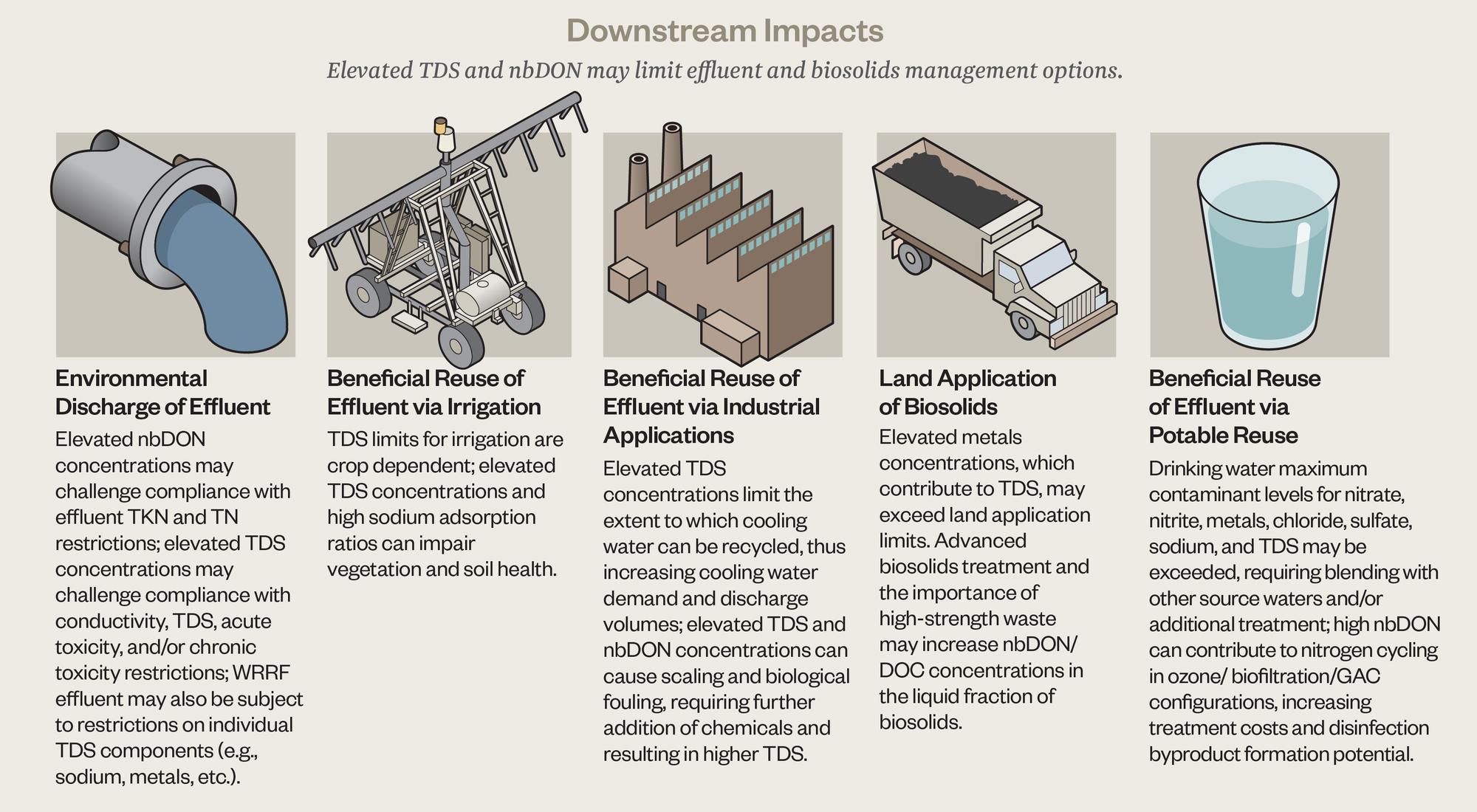
Elevated TDS and nbDON concentrations can complicate permit compliance and ultimately limit the end use of effluent and biosolids, as well as damage infrastructure and impair the performance of many treatment process elements.
Understanding the strategies available to control the concentrations of TDS and nbDON in a wastewater resource reclamation facility (WRRF) collection and treatment system can minimize adverse impacts while avoiding the need for advanced removal technologies.
Related Topics:
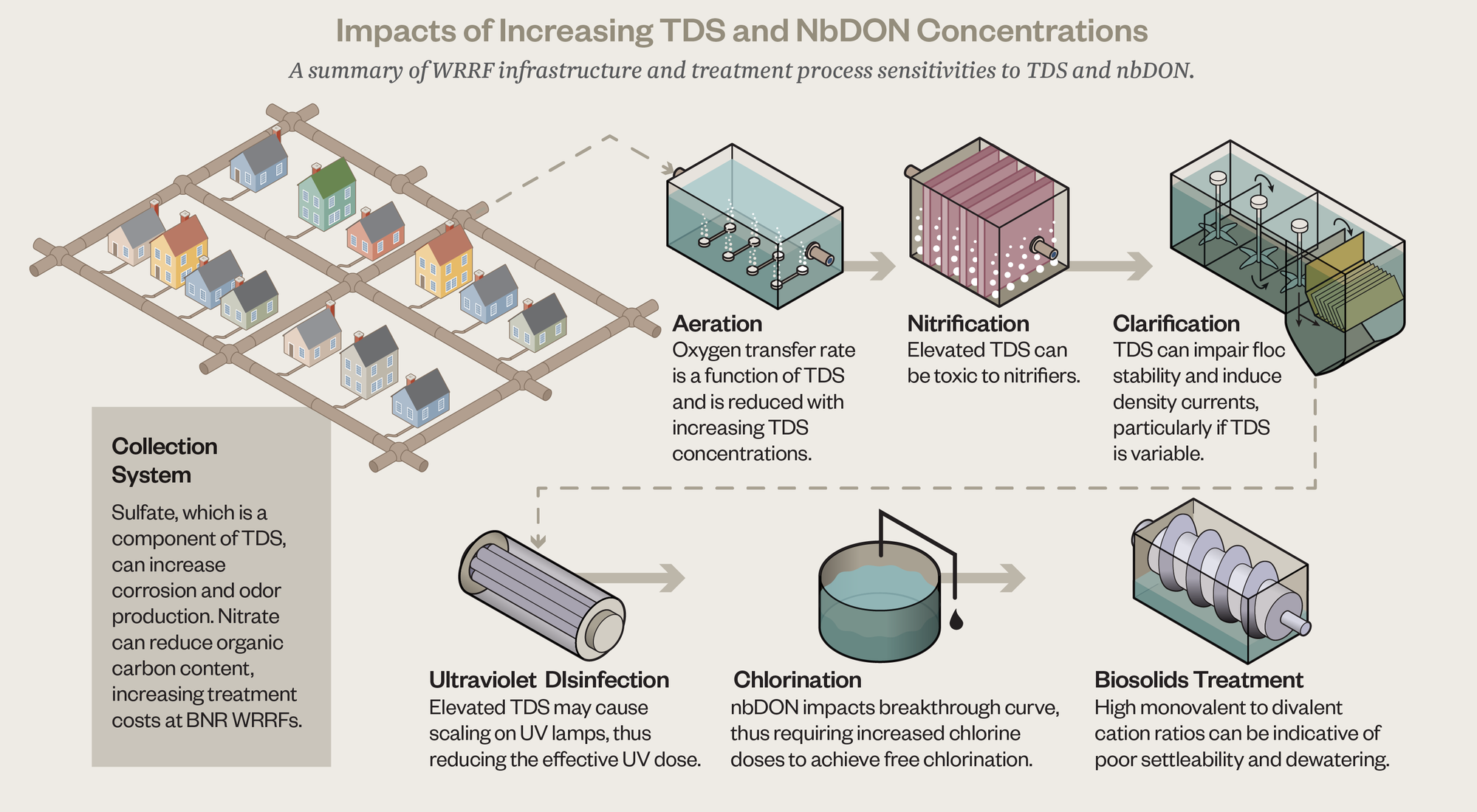
What drives increasing TDS and nbDON at WRRFs?
Population growth, urbanization, and climate change are creating water scarcity in many parts of the world, forcing utilities to consider the use of alternative water supplies. These alternative water supplies, like seawater, brackish groundwater, surface water, stormwater, and reclaimed water, may be more difficult to treat than conventional supplies and also may be characterized by higher concentrations of TDS and/or nbDON.
Source water (i.e., raw drinking water) concentrations have a direct impact on influent and effluent wastewater concentrations. A study by the Southern California Salinity Coalition found that source water TDS was the primary driver for observed variability in influent and effluent wastewater at WRRFs. Wastewater nbDON concentrations are also impacted by source water concentrations, although the correlation is generally weaker because nbDON treatment barriers (floc/sed, activated carbon) are more common at water treatment facilities than TDS treatment barriers.
Drinking water treatment may increase the concentrations of TDS and/or individual TDS components. For example, anion exchange and cation exchange impact the composition of TDS replacing certain anions and cations with chloride and sodium, respectively. Metal salt coagulants also contribute to TDS. Sedimentation, adsorption, and biologically active filtration (BAF) can impact nbDON concentrations in finished drinking water.
Drinking water treatment facilities can also increase TDS and nbDON concentrations at WRRFs through the discharge of residuals to the collection system. Membrane concentration, exhausted ion exchange regeneration brine, settled solids, and other residuals can contain can contain high TDS and nbDON concentrations. Drinking water treatment residuals at the household level can also impact TDS and nbDON at WRRFs, such as the high chloride discharges that are produced by self-regenerating water softeners.
TDS and nbDON concentrations at WRRFs are highly dependent on how drinking water is used by residential, commercial, and industrial customers. Water conservation (passive and active) will continue to play an important role in water resource management as it acts to reduce the extent to which discharges are diluted by drinking water prior to arrival at WRRFs. The Southern California Salinity Coalition estimates that for every gallon per capita per day decline in indoor water use, there is a 1.2 to 1.7 mg/L increase in WRRF influent TDS.
Sewershed management practices and wastewater treatment may increase TDS and nbDON concentrations in WRRF influent and effluent. Utilities may opt to add chemicals to the collection system to minimize odor production and/or corrosion. Additional chemical inputs may be dosed at the WRRF for pH control, biological and chemical nutrient removal, and other applications, all possibly increasing TDS.
Importantly, water conservation can exacerbate the need for chemical inputs in the collection system and thus the potential for TDS increases because reduced flows in the collection system lead to an increased potential for odors and corrosion. Biosolids treatment processes, such as thermal hydrolysis pretreatment ahead of anaerobic digestion, can also increase nbDON in return flows.

How Can I Manage It?
Source Water Selection
Purposeful selection and prioritization of source waters based on TDS and nbDON can minimize TDS and nbDON in finished drinking water, in turn minimizing these concentrations in WRRF influent and effluent.
Brick Township, NJ is a coastal utility that relies on surface water as its primary source water. The surface water supply is subject to riverine salinity intrusion, as well as increasing levels of chloride from urbanization and road salt.
To avoid the need for TDS removal at the water treatment plant, the Township switches to the use of a reservoir when the salt front gets within 1,000 feet of the intake or the specific conductivity of the source water exceeds 1,000 μS/cm. Hazen worked with the Township to model future salinity-based reliance on the pumped storage reservoir and recommend adaptation strategies.
Modeled outputs showed that the river was projected to be unusable for 100 days per year by 2040 in the absence of adaptation strategies. Reservoir improvement, which would allow for additional pumped storage when river water is unusable, was ranked as the most effective adaptation strategy for increasing the safe yield of surface water supplies and avoiding adverse impacts from elevated salinity levels. This work demonstrates how a utility can proactively manage its source water to comply with drinking water limitations (e.g., chloride, TDS) without additional treatment, while also limiting the loads of those constituents that are delivered to WRRFs as wastewater.
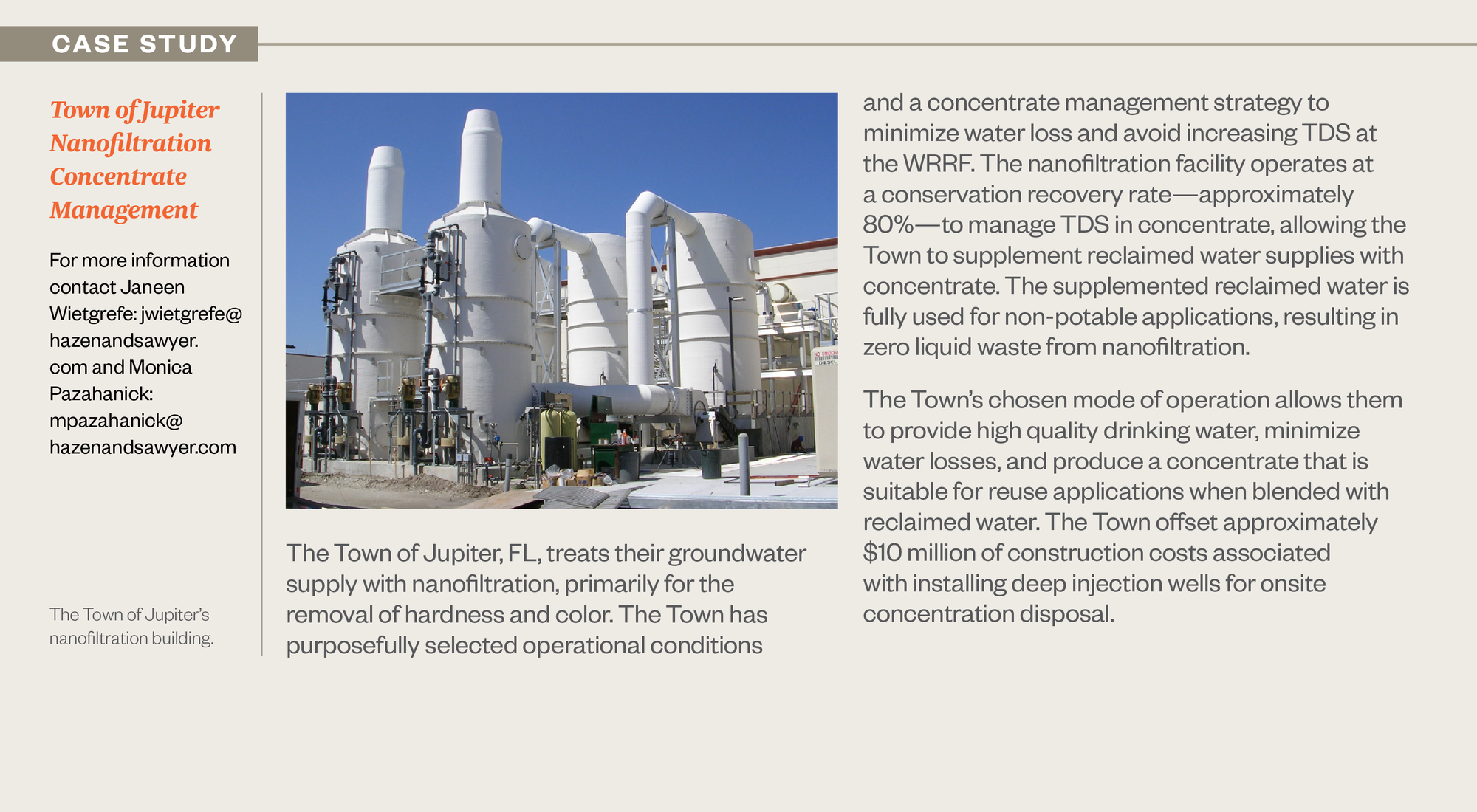
Drinking Water Treatment Residuals Management
Drinking water treatment residuals can be managed to minimize TDS and nbDON impacts at WRRFs. Strategies include the minimization of residuals production, pretreatment of residuals prior to discharge to the collection system, and alternative disposal options that do not involve the WRRF.
The Town of Jupiter, FL, treats their groundwater supply with nanofiltration, primarily for the removal of hardness and color. The Town has purposefully selected operational conditions and a concentrate management strategy to minimize water loss and avoid increasing TDS at the WRRF. The nanofiltration facility operates at a conservation recovery rate—approximately 80%—to manage TDS in concentrate, allowing the Town to supplement reclaimed water supplies with concentrate. The supplemented reclaimed water is fully used for non-potable applications, resulting in zero liquid waste from nanofiltration.
The Town’s chosen mode of operation allows them to provide high quality drinking water, minimize water losses, and produce a concentrate that is suitable for reuse applications when blended with reclaimed water. The Town offset approximately $10 million of construction costs associated with installing deep injection wells for onsite concentration disposal.
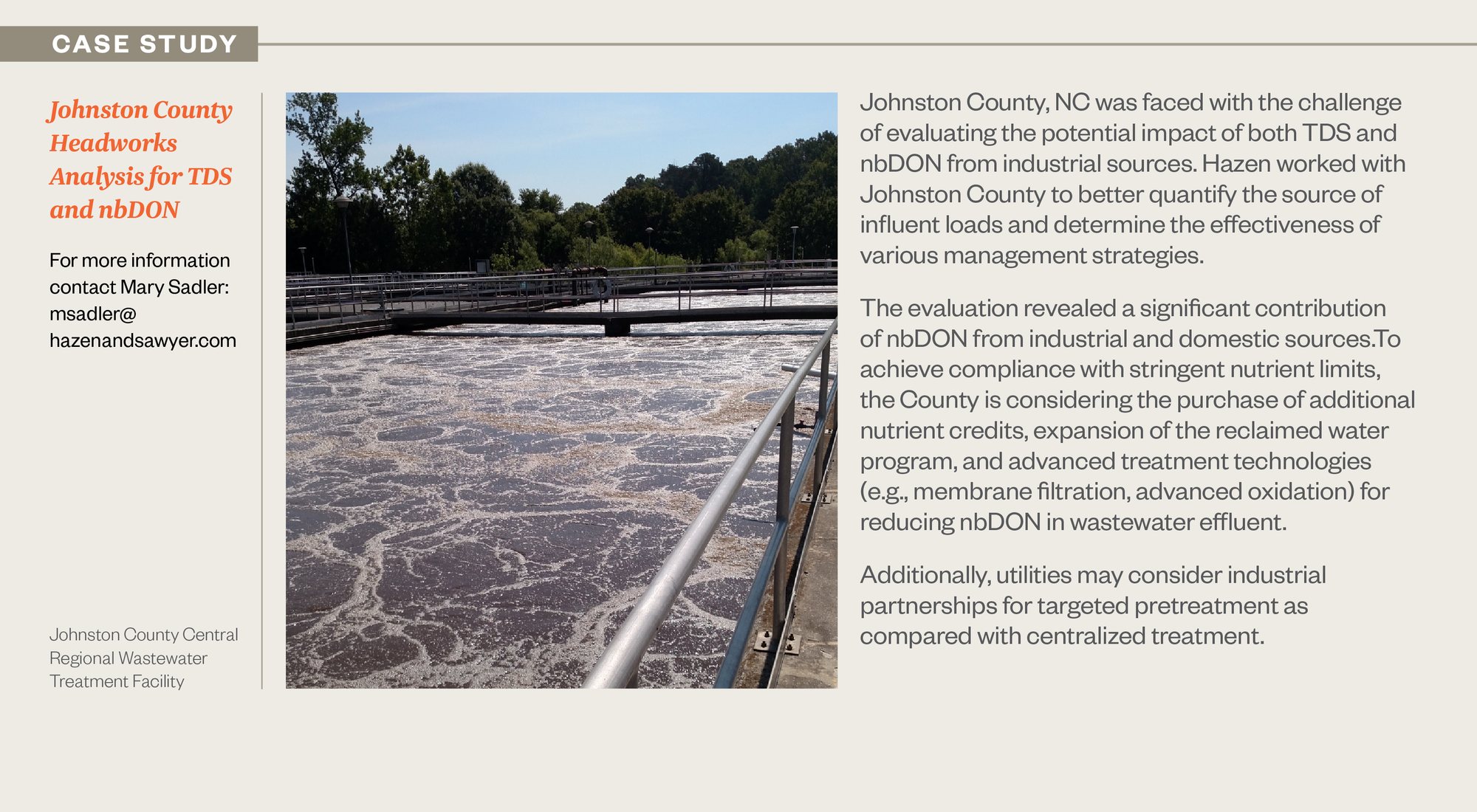
Sewershed Surveys and Headworks Analyses to Address TDS, nbDON at the Source
Sewershed surveys, headworks analysis, and local limits evaluations are an opportunity for utilities to focus on the larger impact of individual discharges on wastewater treatment. These evaluations are particularly important when a utility receives a request to discharge pollutants that are not specifically regulated. A comprehensive understanding of the relative contributions of nbDON and TDS from sources upstream of the WRRF are required to evaluate management via pretreatment, collection system improvements, collection system flow splitting, and/or WRRF treatment enhancements.
Johnston County, NC was faced with the challenge of evaluating the potential impact of both TDS and nbDON from industrial sources. Hazen worked with Johnston County to better quantify the source of influent loads and determine the effectiveness of various management strategies.
The evaluation revealed a significant contribution of nbDON from industrial and domestic sources.To achieve compliance with stringent nutrient limits, the County is considering the purchase of additional nutrient credits, expansion of the reclaimed water program, and advanced treatment technologies (e.g., membrane filtration, advanced oxidation) for reducing nbDON in wastewater effluent.
Additionally, utilities may consider industrial partnerships for targeted pretreatment as compared with centralized treatment.
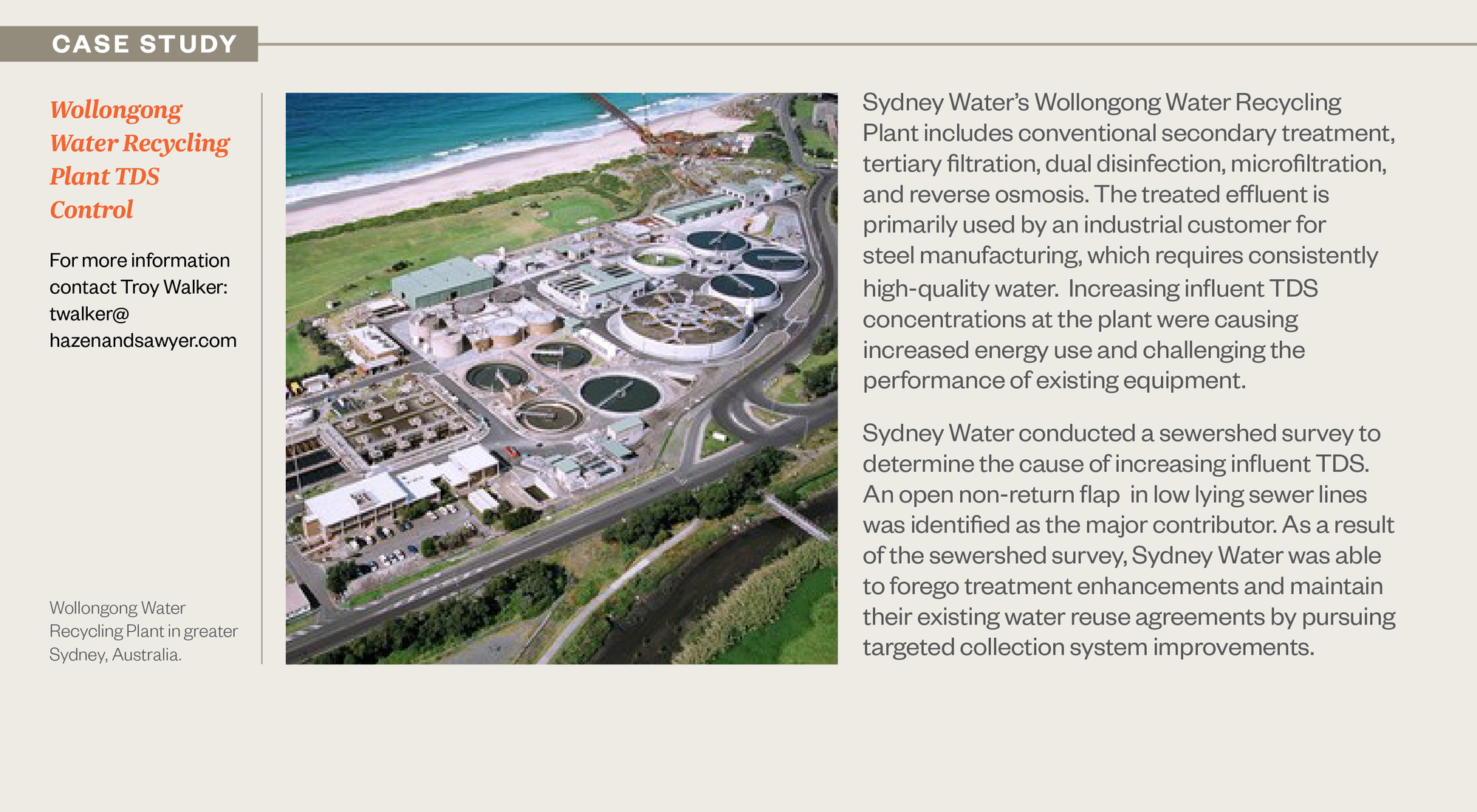
Sydney Water’s Wollongong Water Recycling Plant includes conventional secondary treatment, tertiary filtration, dual disinfection, microfiltration, and reverse osmosis. The treated effluent is primarily used by an industrial customer for steel manufacturing, which requires consistently high-quality water. Increasing influent TDS concentrations at the plant were causing increased energy use and challenging the performance of existing equipment.
Sydney Water conducted a sewershed survey to determine the cause of increasing influent TDS. An open non-return flap in low lying sewer lines was identified as the major contributor. As a result of the sewershed survey, Sydney Water was able to forego treatment enhancements and maintain their existing water reuse agreements by pursuing targeted collection system improvements.










